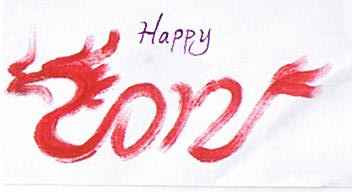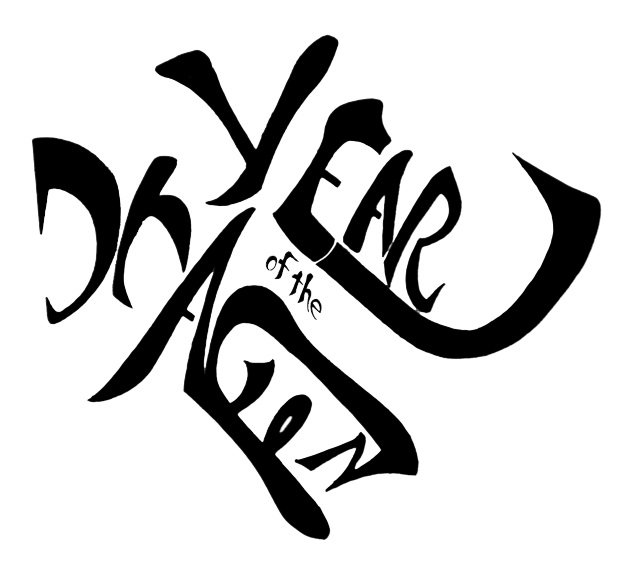Happy LÓNG year!
« previous post | next post »
Every year around this time, I write about the relevant Chinese zodiacal animal. Here are some recent posts:
2012 is the year of the dragon, which in Modern Standard Mandarin is lóng (simplified 龙 traditional / complicated 龍).
Here is an ambigram designed by by Eric Pelzl, professor at Wisconsin Lutheran College, which simultaneously writes 龍 and "Year of the Dragon":
Now, even dragons have to eat, and it would appear that one of their favorite foods is pizza.
The sign at the top says “lóng kǒufú bǐsà” 龙口福比萨, which does not mean, as the Chinglish translation provided mistakenly declares, "Dragons eat pizza", but rather roughly (though not literally) something like "delicious pizza for dragons".
The sign at the bottom announces "bǐsà wài sòng" 比萨外送 ("pizza delivery"), for which the Chinglish translation given is "PIZZA OUTSIDESEND".
A note on the Chinese transcription of "pizza" (bǐsà 比萨): bǐ 比 by itself means "compare", but here it is being used strictly for its sound, while sà 萨 by itself means nothing, since it normally is used solely to indicate the second syllable of the abbreviated Chinese transcription of the Sanskrit word "bodhisattva", viz., púsà 菩萨.
A couple of dragon year quips:
May the New Year be LÓNG but not drag-on!
Happy Year of the Dragon, "long" time no see!
Incidentally, it is said by some that the second, widely used clause of the above greeting may be based on Chinese grammar, as in Mandarin hǎo/hěnjiǔ bùjiàn 好/很久不见 (lit., "very long not see") or perhaps more likely Cantonese hou2 noi6 mou5 gin3 好耐冇見 // hou2 noi6 m4 gin3 好耐唔見 (both of which mean "very long time not see").

[A tip of the hat to Toni Tan, David Moser, Mark Swofford, Hoong Teik Toh, and Nick Kaldis]


June Teufel Dreyer said,
January 24, 2012 @ 2:02 pm
love it—thanks!
MB said,
January 24, 2012 @ 2:29 pm
and fortuitously long as a leap year in the West.
Jonathan said,
January 24, 2012 @ 2:55 pm
MB makes a good point. Every LÓNG year is a long year, except those divisible by 100 but not 400).
Carl said,
January 24, 2012 @ 3:47 pm
Interesting that Japan chose to simplify 龍 down to 竜 instead of going nuts with 龙. Visually, 龍 and 竜 seem pretty close to me, but 龙 is too abstract for me to see the connection.
The Japanese also still use 龍 pretty often, unlike 學 which is now exclusively 学, etc.
Rubrick said,
January 24, 2012 @ 6:22 pm
I am enamored of a language in which a syllable is used for millennia for the sole purpose of helping to express "enlightened being", and then is pressed into service for fast food.
Matt said,
January 24, 2012 @ 7:33 pm
The Japanese 竜/龍 thing is interesting. 竜 is on the joyo kanji list, with 龍 given as the old/"unsimplified" form. (AFAIK there is no direct link between the two characters, so it's more an arbitrary decision to merge the two into one than a "simplification" from one to the other — but maybe Victor knows more.)
龍 is therefore not on the joyo kanji list as an independent entry. But it IS on the list of kanji approved for use in names (as an alternate form of 竜, natch). And it gets used in names a lot, so pretty much everyone learns how to read it at least and there is not a lot of resistance to its use in other contexts. (Unlike 學, which is NOT on the list of kanji approved for names, and so it sees basically no modern use at all.)
Unscientifically and anecdotally, I believe that I have observed a tendency to use 竜 for Euro-style dragons (and dinosaurs!), and 龍 for Chinese-style dragons. I also see 龍 in names more often, probably because it looks cooler.
Doc Rock said,
January 24, 2012 @ 8:21 pm
I would translate 龙口福比萨 as "dragons 龙 you've arrived in time for a treat 口福 pizza 比萨." Or better, perhaps, as "dragons, you've arrived in time for a pizza treat." The character combination 口福 means "arrival in time for a culinary treat" 口 mouth + 福 luck.
Nathan Hopson said,
January 24, 2012 @ 8:45 pm
Thing is, it's usually 辰年 in Japanese…
At the risk of oversimplification, 龍 and 竜 are the characters used for dragons (general), while 辰 is for the zodiac dragon (specific).
Nathan Hopson said,
January 24, 2012 @ 8:47 pm
Oh, and it's also a leap-second year, so it's extra-extra long…
http://goo.gl/AlBuJ
Doc Rock said,
January 24, 2012 @ 8:52 pm
BTW, according to the Kangxi Dictionary 康熙字典 complied in 1710, the Jíyùn 集韻、 "Collected Rimes," a Chinese rime dictionary published in 1037, stated that 竜 was an old form of 龍 [龍古作竜].
Vladimir Menkov said,
January 24, 2012 @ 11:02 pm
Interestingly, in the Kazakh version of the 12-year animal cycle, which otherwise is quite similar to the Chinese, the new year is the year of the snail, rather than of the dragon:
Vladimir Menkov said,
January 24, 2012 @ 11:22 pm
Rubrick: the character 萨 (sa), besides pusa ("bodhisattva") and bisa ("pizza"), has long been used in a number of foreign/ethnnic place names, such as 拉萨 Lasa "Lhasa" or 哈萨克 Hasake (zu/yu/sitan) "Kazakh (ethnicity/language/-stan)".
Matt said,
January 25, 2012 @ 12:03 am
Doc Rock: That's it! I was misremembering my trivia. It's not that 龍 and 竜 are unrelated, it's that 竜 is supposedly the original (older) form and 龍 is a "complicated" form that arose later. Thanks for the correction.
Chad Nilep said,
January 25, 2012 @ 12:22 am
@Matt
During the New Year Grand Sumo Tournament, television announcers noted several athletes with "Dragon" in their sumo names. I noticed that both kanji are used. Examples include 妙義龍 (Myogiryu) and 千代大龍 (Chiyotairyu), who use the traditional form, and 鶴竜 (Kakuryu), who uses the simplified version.
Weiz said,
January 25, 2012 @ 4:18 am
@Carl, I would disagree that 龙 is going nuts. it's actually one of the cursive forms in Chinese caligraphy for 龍. the simplified 学, the top part is the cursive form of the top part of 學.
Ian said,
January 25, 2012 @ 5:45 am
The anbigram also looks like a dragon's head.
Leonardo Boiko said,
January 25, 2012 @ 6:35 am
I like how the (non–Sino-) Japanese morpheme for dragon is tatsu, and both 龍 and 竜 happen to include 立 “to stand”, whose standard kun reading/translation is ta-tsu. Accidentally phonetic components!
Doc Rock: I had no idea that 竜 was supposed to be older! If Sears didn’t make a mistake, the bilaterality of 龍 seems to go back to Seal at least http://www.chineseetymology.org/CharacterEtymology.aspx?characterInput=%E9%BE%8D
The Chinese don’t commonly use the Twelve Branches–specific characters like 辰、 巳、 酉 etc? In Japanese I see them often in 十二支 contexts such as years and hours and zodiacs, as Nathan pointed.
janet roberts said,
January 25, 2012 @ 9:14 am
I love all this enthusiasm about language; it is poetry. Thank you! It has created a smile and joy in experiencing the year of the dragon.
Richard Sears said,
January 25, 2012 @ 9:53 am
龙 – 龍 – "Super cursive" Chinese 草书 is far more than just "super sloppy" Chinese. It is a very sophisticated set of rules for simplifying Chinese. Many simplified characters come from the "restrokification" 楷书话 of super cursive Chinese. According to the rules龙can be explained as 1. the first horizontal stroke of the left hand side of龍. 2. a single vertical stroke indicating the whole left side of龍 3. the first stroke type of the right hand side of龍 4. the last two stroke types of the right hand side of龍.
龍 can be traced back graphically to its oracle bone form, obviously a snake with something on top of its head. Some speculate it is a crown. I believe it is an upside down man 立 which, as in a number of other characters indicates a dead man as opposed to a live man立 which can stand up. Thus a snake which can kill, thus the king of snakes, no doubt the cobra.
http://www.chineseetymology.org/CharacterEtymology.aspx?submitButton1=Etymology&characterInput=%E9%BE%99
You have got to see this. (The "true" meaning of long) or as the narrator calls it "loong"
http://www.youtu.be/watch?v=Xi-QHvfQfHo
Matt Anderson said,
January 25, 2012 @ 10:06 am
As Leonardo Boiko points out above, 龍 is the most common form in Sears's Seal category, but the form 竜 is also well-represented there. Sears's L29687 and L29698 are the most obvious, but forms like his L00110 and L29688, among others, are also ancestors of 竜. As can be seen further down on that page, the oracle-bone forms aren't structurally the same as either 竜 or 龍, but it's easier (to me at least) to see how they could have been standardized as 竜 than as 龍, though neither is really too much of a stretch. So I'd say both forms seem to be about equally old.
Happy Lóng year!
John Major said,
January 25, 2012 @ 1:11 pm
;Further to Nathan Hopson's comment, it is a peculiarity of the Japanese calendar that the name of each the twelve cycilcal years ("zodiac" is a misnomer) are written with the characters for the twelve Earthly Branches (dizhi, 地支) but pronounced as the name of the animal for that year. So for example the first year of the cycle is designated 子 but pronounced "nezumi" (as if it were written 鼠) rather than the more usual "shi"or "ko". In Chinese cosmology the Heavenlly Branches are also used to designate the twelve months of the year, and the twelve years of the Jupiter cycle, but they always are pronounced as the dizhi, not as their animal counterparts. So 子as a year-designator is pronounced "zi," not "shu" (as if it were written 鼠.)
JG said,
January 25, 2012 @ 4:58 pm
@Doc Rock:
I would translate 龙口福比萨 as Long Kou Fu Pizza…
Carl said,
January 25, 2012 @ 8:33 pm
I would translate 龙口福比萨 as "Face it, Dragon… Your tastebuds just hit the pizza jackpot!"
Olof said,
January 26, 2012 @ 2:59 am
Seems like it should be Pelzl, rather than Pelzi. Sorry to be so pedantic, but an ambigram that cool deserves proper credit.
VHM: the typo has now been corrected; thanks
william zhang said,
January 27, 2012 @ 12:07 am
Dr. Mair, Do you think that 龍口can be the name of a city in China?
Gummyworms said,
January 27, 2012 @ 12:29 am
I have seen two different ways of writing "pizza". Can anyone tell me which is the standard form?
1. 披萨 (pīsà)
2. 比萨
John F said,
January 27, 2012 @ 7:53 am
You must defeat Sheng Long to stand a chance.
http://www.capcom-fc.com/sf4/thumbnail/040201.jpg
Leonardo Boiko said,
January 27, 2012 @ 11:20 am
(For those not in the know: The American localization of the 1991 videogame Street Fighter II famously mistranslated Ryū's trademark karate move, the Rising Dragon Fist 昇龍拳 shōryūken, as “Sheng Long” (the pinyin reading would be shēng lóng quán) . This spawned a number of rumors and hoaxes about a mysterious warrior named Sheng Long.)
Andy said,
January 27, 2012 @ 7:04 pm
Bravo!
Let's hope it is as good as it is long!
Gpa said,
January 28, 2012 @ 7:13 pm
"Do you think that 龍口can be the name of a city in China?"
It's not the name of a Chinese city, but 龍口 is a brand name of certain food products.
Bob Violence said,
February 1, 2012 @ 2:33 pm
There's a city in Shandong called 龙口市, although it's not what English-speakers would usually consider a city (it's a "county-level city").
Jerome Rainey said,
February 5, 2013 @ 6:38 pm
I've had a copy of Eric Pelzl's ambigram on my office door for the last year, courtesy of this article. My Chinese colleagues are always surprised when they discover that it can be read in English, since it reads so well as Chinese.
Is there a snake version for the coming year?